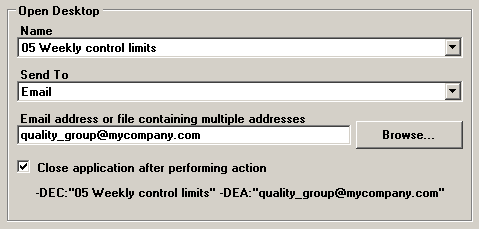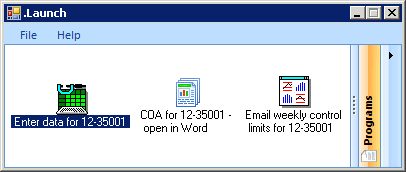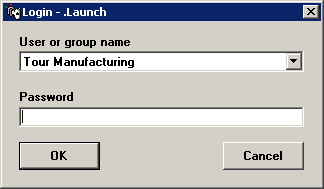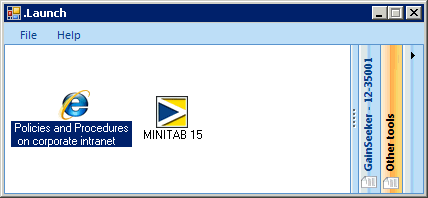Launching GainSeeker modules from the .Launch module
Introduction to the .Launch module
You can use the .Launch module to:
Configuring and deploying the .Launch module
Logging in to configure the .Launch module
Start the .Launch module from the Windows
Start menu or create
a shortcut for the .Launch module.
You can use one of the following methods for
logging in to configure the .Launch module:
Configure
.Launch settings for the current GainSeeker user
This method works well if the role
for the GainSeeker
user for whom you are configuring the .Launch settings has Change
and Edit Rights \ .Launch settings enabled.
Make sure that no other workstations
are currently logged in to the .Launch module as the GainSeeker
user for whom you are configuring the .Launch settings.
Log in to the .Launch module as the GainSeeker
user for whom you are configuring the .Launch settings.
If a login password is set for this user, you may need to ask this
user to enter their password.
Configure
.Launch settings for another GainSeeker user
This method works well if the role for the GainSeeker
user for whom you are configuring the .Launch settings does not have Change and Edit Rights \ .Launch settings
enabled.
Make sure that no other workstations
are currently logged in to the .Launch module as the GainSeeker user
for whom you are configuring the .Launch settings.
Log
in to the .Launch module as any user that is assigned to a role with
the following rights enabled:
Change
and Edit Rights \ .Launch settings
Module
Access \ Administration
Miscellaneous
\ See all users, roles and configurations
Click the File
menu and then click Edit Another
User. This will display a message like the following:

Click OK
on the message window. Now the Login
window is displayed:
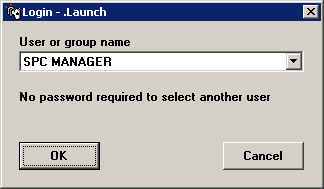
Click the User
or group name list, select the user for whom you are configuring
the .Launch settings, and then click OK.
This will log you in to the .Launch module as the selected user with
the rights listed above temporarily
enabled.
Configure the .Launch settings for the
selected user.
When finished configuring .Launch settings
for the selected user, you should close the .Launch module or repeat
step 3 to edit another user.
Configure .Launch settings for the current GainSeeker
user and copy them to other users
This method works well if you are configuring
.Launch settings for multiple GainSeeker users who do not yet have any
.Launch settings configured.
 Note:
This method will completely overwrite all of the .Launch settings
– shortcuts,
groups and other .Launch properties –
for the users to whom you copy your settings. Note:
This method will completely overwrite all of the .Launch settings
– shortcuts,
groups and other .Launch properties –
for the users to whom you copy your settings.
It will also configure the .Launch settings for the User
or group name you use to log in to the .Launch module.
|
Make sure that no other workstations
are currently logged in to the .Launch module as the GainSeeker users
for whom you are configuring the .Launch settings.
Use either method listed above – Configure
.Launch settings for the current GainSeeker user or Configure
.Launch settings for another GainSeeker user – to log in as the user whose .Launch
settings you want to configure and then copy to other users.
Configure the .Launch settings for this
user.
After configuring all of the shortcuts,
groups and other .Launch properties for this user:
Click the File
menu and then click Copy to Other
Users.
Select one or more users you want
to configure, and then click OK.
If .Launch settings
have already been configured for a user, GainSeeker will display a window
like this to make sure you really want to overwrite their existing .Launch
settings:
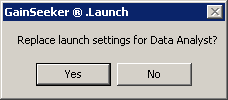
Export and import .Launch settings
This method works well if you need to export
.Launch settings from one system and then import them into another. If
you only need to copy settings from one user to another on your system,
you should use the instructions for copying
.Launch settings to other users.
To
export .Launch settings:
Log in to the .Launch module as a user
with rights to export settings.
Click the File
menu and then click Export Settings.
Select the user whose settings you want
to export, and then click OK.
Browse to the folder where you want to
create the export file, enter a name for the export file, and then
click Save.
To import .Launch settings:
 Note:
These steps will completely overwrite all of the .Launch settings
– shortcuts,
groups and other .Launch properties –
for the users to whom you import settings. Note:
These steps will completely overwrite all of the .Launch settings
– shortcuts,
groups and other .Launch properties –
for the users to whom you import settings.
|
Make sure that no other workstations
are currently logged in to the .Launch module as the GainSeeker user
for whom you are importing .Launch settings.
Log in to the .Launch module as a user
with rights to import settings.
Click the File
menu and then click Import Settings.
Browse to the folder that contains the
.Launch settings file (*.dlx) that you want to import.
Click the file to import, and then click Open.
Select the user for which you want to
import these settings, and then click OK.
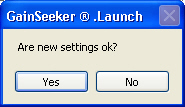
Click Yes
to keep the new settings you have imported or No
to revert to your previous .Launch settings.
Saving changes to .Launch settings
GainSeeker will automatically save your changes
when you add or edit shortcuts, groups and other .Launch properties.
Working with shortcut groups
You can use Groups
to organize short, manageable lists of related shortcuts.
For example, the .Launch screen below has
been configured with a group for each of three part numbers (12-35001,
13-00165 and 14-27414) and a fourth group for other tools:
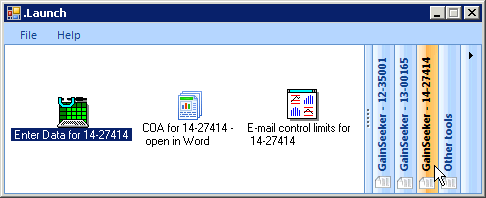
If the current size of the .Launch screen cannot
display the full names of all groups, the groups will be minimized to
icons like the example below. One or more groups may also be minimized
to icons if you slide the separator bar or click the  button to show fewer buttons.
button to show fewer buttons.

By default, the .Launch module will display a
single Programs group to which
you can add shortcuts.
Adding a new group
Click the File
menu and then click New Group.
Type a name for the new group,
and then click OK.
Renaming a group
Click on the group you want to rename.
Click the File
menu, point to Edit Group,
and then click Rename.
Type a name for the new group,
and then click OK.
Changing the order in which groups appear
Click on the group that you want to move.
If the .Launch module is configured for
horizontal orientation: click
the File menu, point to Edit Group, and then click Move Left or Move
Right.
If the .Launch module is configured for vertical orientation: click
the File menu, point to Edit Group, and then click Move Up or Move
Down.
Deleting a group
Click on the group that you want to delete.
Click the File
menu and then click Remove Group.
When prompted to delete the group, click
OK.
Working with shortcuts
Adding
a new shortcut for a GainSeeker module
Click the group where you want the new
shortcut to appear.
Click the File
menu and then click New GainSeeker
Item.
This will display the
Launch GainSeeker Item screen:

Click the GainSeeker
Application list and choose the GainSeeker module for which
you want to create a shortcut.
Click the Startup
Action list (if available) and choose the type of action that
you will want this shortcut to automatically perform.
(optional)
If you want this shortcut to log in to this GainSeeker module as a
different
user, log in to a different
configuration and/or log in using different
database connection information, click Advanced
and choose the desired options.
Click
OK to continue. This will
display the GainSeeker Item Settings
screen:
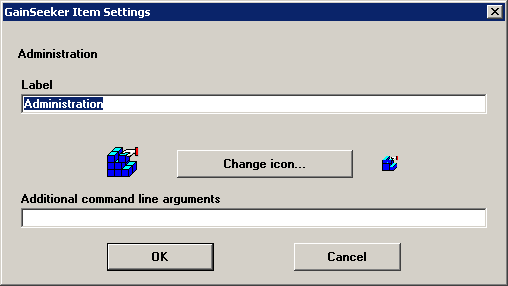
The options available on this screen will vary based on the GainSeeker
Application and Startup Action
you selected on the previous screen.
If you specified any Advanced
options on the previous screen, the resulting command line parameters
for those options will be displayed in the upper right corner of this
screen. Also, any lists of items (standards, processes, data entry
templates, etc.) shown on this screen are based on the Advanced
options you selected.
To change the text that will be displayed
on this shortcut, enter the desired text in the Label
box.
If you want this shortcut to display just the icon with no text label,
delete all text from the Label
box.
To
change the icon that will be displayed on this shortcut:
Click Change
icon. This will display the Change
Icon screen:

Choose an option from the Change
Icon screen and then click OK.
If you selected a Startup
Action on the previous screen, configure the settings for that
action.
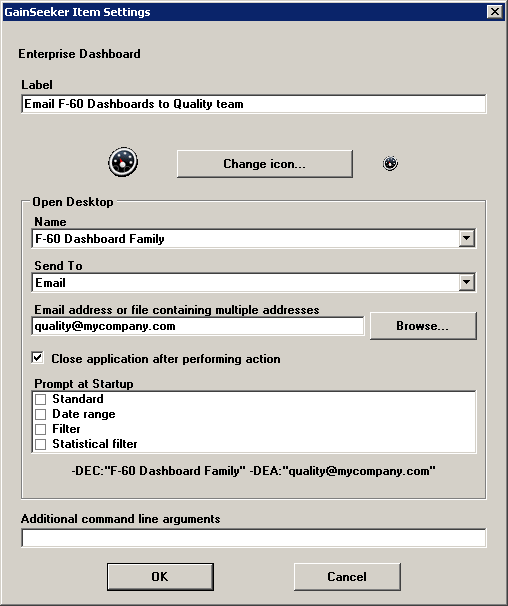
The options available on this screen will vary based on the GainSeeker
Application and Startup Action
you selected on the previous screen.
As you configure the options for the Startup
Action you selected, the resulting command line parameters
will be displayed at the bottom of this area. For example: in the
picture above, an Enterprise Dashboard shortcut to open the desktop
named "F-60 Dashboard Family", e-mail it to "quality@mycompany.com"
and then close the Enterprise Dashboard module will automatically
add -DEC:"F-60 Dashboard Family"
-DEA:"quality@mycompany.com" to the command line
for this shortcut.
For more information on configuring the options available for startup
actions, see Setting
up shortcuts for automatic functions.
If you want to specify additional command
line parameters that are valid for this GainSeeker module but not
displayed on this screen, enter them in the Additional
command line arguments box. For more information, see Setting
up shortcuts for automatic functions.
Click OK
to finish adding this shortcut to the selected group.
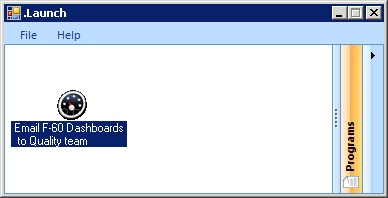
Adding a new shortcut for another program,
file or web address
Click the group where you want the new
shortcut to appear.
Click the File
menu and then click New Item.
This will display the Launch Item
screen:
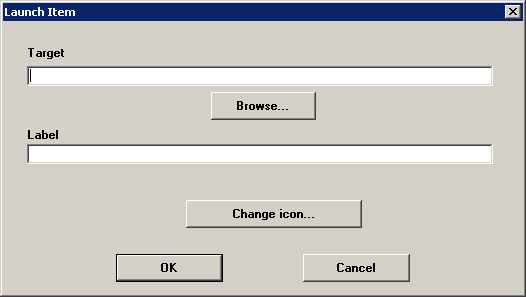
In
the Target box, enter the
name and location of the program, file or web address that you want
this shortcut to launch. If desired, you may click Browse
to locate the program or file.
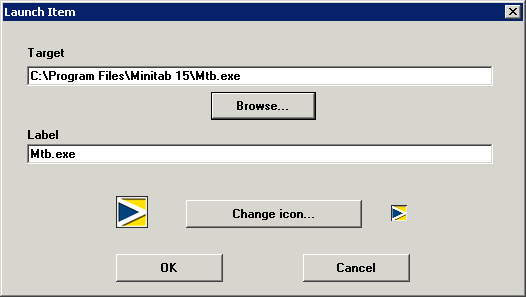
In the Target box, you can
also specify command line parameters for the program or file (if needed).
To change the text that will be displayed
on this shortcut, enter the desired text in the Label
box.
If you want this shortcut to display just the icon with no text label,
delete all text from the Label
box.
To change the icon that will be displayed
on this shortcut:
Click Change
icon. This will display the Change
Icon screen:
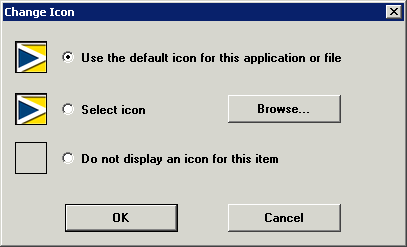
Choose an option from the Change
Icon screen and then click OK.
Click OK
to finish adding this shortcut to the selected group.

Changing a shortcut
To change the settings for a shortcut, right-click
the shortcut and then click Settings.
Alternately, you may click the File
menu, point to Edit Item
and then click Settings
to change the settings for the currently highlighted shortcut.
When changing the shortcut for a GainSeeker module,
you can only change the information on the GainSeeker
Item Settings screen. If you need to specify different information
from the Launch
GainSeeker Item screen - such as the Startup
Action or Advanced properties
- you must create a new shortcut
with the new settings.
Copying a shortcut
to your Windows desktop
To copy a shortcut to your Windows desktop, right-click
the shortcut and then click Send to Desktop.
Alternately, you may click the File
menu, point to Edit Item and then
click Send to Desktop to copy
the currently highlighted shortcut to your Windows desktop.
Changing the order in which shortcuts appear
Right-click the shortcut that you want
to move.
If the .Launch module is configured for
horizontal orientation: click
Move Left or Move
Right.
If the .Launch module is configured for vertical orientation: click
Move Up or Move
Down.
Moving a shortcut to a different group
Right-click the shortcut that you want
to move to a different group, and then click Change
Group.
Select the new group for this icon,
and then click OK.
Deleting a shortcut
Right-click the shortcut that you want to delete,
and then click Remove Item.
Working with other .Launch window properties
Displaying small icons or large icons
To display smaller icons on the .Launch window:
click the File menu, point to
Icon Size and then click Small.
To display larger icons on the .Launch window
(the default setting): click the File
menu, point to Icon Size and then
click Large.
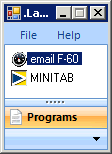
|

|
Small |
Large |
Docking the
.Launch window on your screen
You can dock
the .Launch window along one edge of your screen.
To do so: click the File
menu, point to Dock
and then click Left,
Right, Top
or Bottom.
If you dock the .Launch window on the
Left or Right
edge of your screen, the orientation
of the window will automatically be set to vertical,
and the height of the window will automatically be expanded to the
height of your screen.
If you dock the .Launch window on the
Top or Bottom
of your screen, the orientation of the window will automatically be
set to horizontal, and the
width of the window will automatically be expanded to the width of
your screen.
If you run GainSeeker on a computer with more
than one monitor, the .Launch window will be docked on your primary monitor
only.
Manually setting the orientation, size and
position of the .Launch window
These options will work best if the Dock option is set to None.
Configuring
.Launch for horizontal or vertical orientation
The .Launch module
can be displayed in horizontal or vertical orientation, like the following
examples:
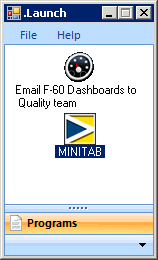
|

|
Vertical |
Horizontal |
To change the orientation
of the .Launch window: click the File
menu, point to Orientation and
then click Vertical or Horizontal.
After changing
the orientation, you may want to change the size of the .Launch window
(below).
Changing
the size and position of the .Launch window
You can click and
drag any of the edges or corners of the .Launch window to adjust its size.
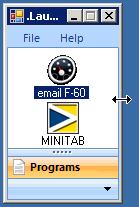
You can also drag
the .Launch window to any location on your screen.
 Note:
The settings for the size and position of the .Launch window
will only be used by the computer where you are working, and they
will be applied for all GainSeeker users who run the .Launch module
on this computer. These settings are not stored on the network
with the other .Launch settings. Note:
The settings for the size and position of the .Launch window
will only be used by the computer where you are working, and they
will be applied for all GainSeeker users who run the .Launch module
on this computer. These settings are not stored on the network
with the other .Launch settings.
|
Using the .Launch module to launch a GainSeeker module or other program
Start the .Launch module and
log in (if needed).
If you don't see the shortcut you want to launch, click the
Group that contains the shortcut you need.

Double-click the shortcut you want to launch.
Alternately, you may press the arrow keys to highlight the desired
shortcut and then press the ENTER key.
